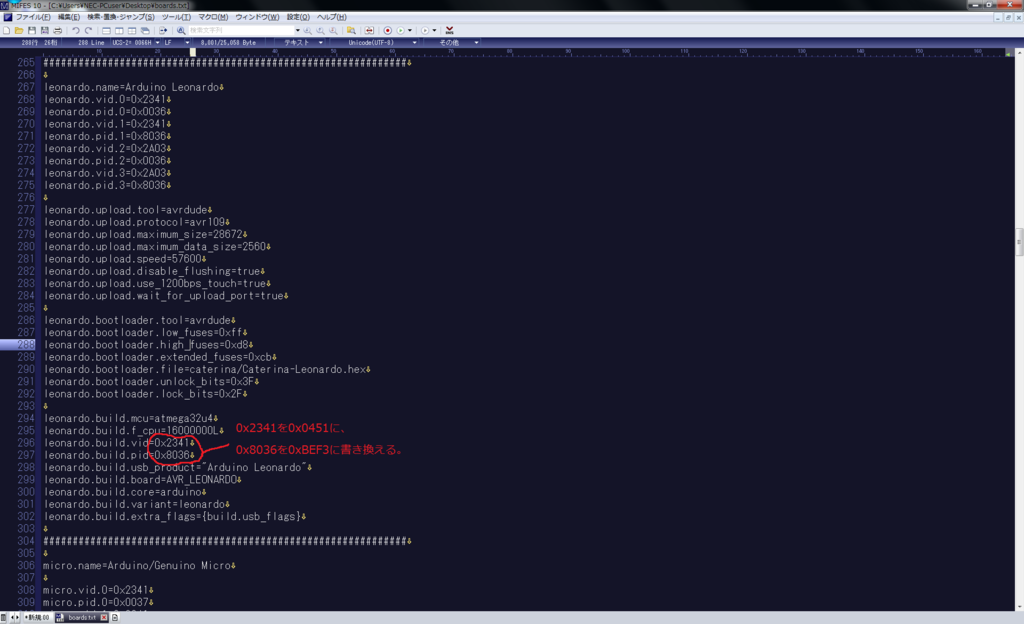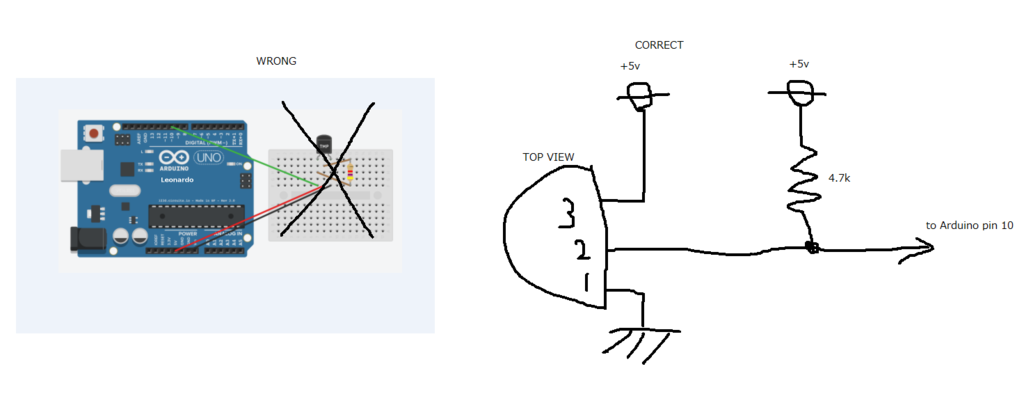TI-Nspire & Arduino を利用した温度計 1、デモを再現する。
まず ASI Temperature - ticalc.org に紹介されているデモを再現してみる。
TI-Nspire はハンドヘルド、マイコンボードは Arduino Leonardo、温度センサーは DS18B20 を使う。
手順:
1. (Student Software しか使わない場合は 1. の作業は不要)C:\Program Files (x86)\Arduino\hardware\arduino\avr\boards.txt を下のように vid=0x0451、pid=0xBEF3 に書き換えて Leonardo を LaunchPad に偽装する。

2. http://playground.arduino.cc/Learning/OneWire の[latest version of the library]リンクをクリックして OneWire ライブラリーをダウンロードする。IDE を起動し、[スケッチ]→[ライブラリをインクルード]→[.ZIP形式のライブラリをインストール...]の順に選択し、今ダウンロードした zip ファイルを選択する。
3. https://github.com/milesburton/Arduino-Temperature-Control-Library にアクセスし、[Clone or download]→[Download ZIP]の順にクリックして zip ファイルをダウンロードする。2. と同じ手順でライブラリをインストールする。
4. 下のスケッチ(Author: Jim Bauwens)をコンパイルして Leonardo に転送する。
/* This program is free software: you can redistribute it and/or modify it under the terms of the GNU General Public License as published by the Free Software Foundation, either version 3 of the License, or (at your option) any later version. This program is distributed in the hope that it will be useful, but WITHOUT ANY WARRANTY; without even the implied warranty of MERCHANTABILITY or FITNESS FOR A PARTICULAR PURPOSE. See the GNU General Public License for more details. You should have received a copy of the GNU General Public License along with this program. If not, see <http://www.gnu.org/licenses/>. */ #include <OneWire.h> #include <DallasTemperature.h> #define ONE_WIRE_BUS 10 OneWire oneWire(ONE_WIRE_BUS); DallasTemperature sensors(&oneWire); DeviceAddress thermometer; void setup(void) { Serial.begin(115200); sensors.begin(); sensors.getAddress(thermometer, 0); sensors.setResolution(thermometer, 12); } float getTemperature(DeviceAddress deviceAddress) { sensors.requestTemperatures(); return sensors.getTempC(deviceAddress); } void loop(void) { float temp; if (Serial.available() > 0) { char c = Serial.read(); switch (c) { case 'T': temp = getTemperature(thermometer); Serial.write('T'); Serial.print(temp); Serial.write(';'); break; default: Serial.print("E;"); } } }
5. 下のスクリプトをハンドヘルドに転送する。
------------------------------------------------------ -- Reads temperature values from a temperture probe -- -- connected to an Arduino Leonardo -- -- (C) 2016 Jim Bauwens -- -- tiplanet.org -- ------------------------------------------------------ -- This program is free software: you can redistribute it and/or modify -- it under the terms of the GNU General Public License as published by -- the Free Software Foundation, either version 3 of the License, or -- (at your option) any later version. -- This program is distributed in the hope that it will be useful, -- but WITHOUT ANY WARRANTY; without even the implied warranty of -- MERCHANTABILITY or FITNESS FOR A PARTICULAR PURPOSE. See the -- GNU General Public License for more details. -- You should have received a copy of the GNU General Public License -- along with this program. If not, see <http://www.gnu.org/licenses/>. platform.apiLevel = '2.7' require 'asi' local connected = false local scanning = true local global_port local temp = "-.--C" --------------------------- -- Set temperature value -- --------------------------- function setTemp(t) temp = t .. "C" platform.window:invalidate() end --------------------------------- -- Request temperature value -- -- Will send 'T' and read port -- --------------------------------- function requestTemp() if global_port then global_port:write('T') global_port:read() end end -------------------- -- Scan for ports -- -------------------- function startScanning() asi.startScanning(portFoundCallback) scanning = true platform.window:invalidate() end ---------------------------------- -- ASI state change callback -- -- If ASI is on, start scanning -- ---------------------------------- function asiStateCallback(state) if state == asi.ON then startScanning() end end -------------------------------- -- Port found callback -- -- Will try to connect to the -- -- discovered port -- -------------------------------- function portFoundCallback(port) port:connect(connectionCallback) end ------------------------------------------ -- Port connection state callback -- -- -- -- On connection it will stop scanning, -- -- set the read listeneren and send an -- -- initial temperature probe -- -- -- -- On disconnection it will start to -- -- scan again for ports -- ------------------------------------------ function connectionCallback(port, event) if event == asi.CONNECTED then connected = true asi.stopScanning() scanning = false port:setReadListener(readCallback) global_port = port requestTemp() elseif event == asi.DISCONNECTED then connected = false temp = "-.--C" startScanning() end platform.window:invalidate() end ------------------------------------------------- -- Called after data is read from the device -- -- Data is send with the format 'XDATA;' where -- -- X is used as data type identifier -- ------------------------------------------------- function readCallback(port) local data = port:getValue() if data then local response = data:split(';') -- there could have been multiple packets send -- we need to handle them individually for k,v in ipairs(response) do doResponse(v:sub(1,1), v:sub(2)) end end end ---------------------------- -- Handle device response -- ---------------------------- function doResponse(rtype, data) if rtype == 'T' then setTemp(data) -- After receiveing temperature, probe for an updated temperature requestTemp() end end ------------------------------------------- -- Start listening for ASI state changes -- ------------------------------------------- function on.construction() timer.start(5) asi.addStateListener(asiStateCallback) end ------------------------------------ -- Force temperature probe update -- ------------------------------------ function on.enterKey() requestTemp() end function on.tabKey() -- fake temperature temp = "13.42C" platform.window:invalidate() end function on.timer() -- request at least every 5s an update requestTemp() end --------------------- -- Draw everything -- --------------------- function on.paint(gc, x, y, width, height) gc:setFont("sansserif", "r", 7) gc:drawString("Connected: " .. tostring(connected) .. ", scanning: " .. tostring(scanning), 2, 2, "top") gc:setFont("serif", "b", 24) gc:setColorRGB(0xFF0000) local w,h = gc:getStringWidth(temp), gc:getStringHeight(temp) gc:drawString(temp, (width-w)/2, (height-h)/2, "top") end
6. 温度センサー(DS18B20)と Leonardo とを下のように接続する。上の参考 URL にある接続図は間違っているので注意が必要。あとはハンドヘルドをホストにして Leonardo に接続し、5. のスクリプトを実行すれば温度が表示される。
